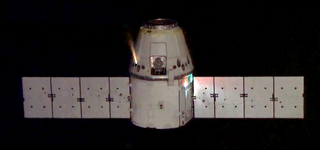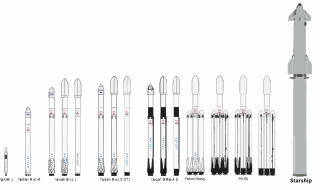
Spacecraft propulsion is any method used to accelerate spacecraft and artificial satellites. In-space propulsion exclusively deals with propulsion systems used in the vacuum of space and should not be confused with space launch or atmospheric entry.

An ion thruster, ion drive, or ion engine is a form of electric propulsion used for spacecraft propulsion. An ion thruster creates a cloud of positive ions from a neutral gas by ionizing it to extract some electrons from its atoms. The ions are then accelerated using electricity to create thrust. Ion thrusters are categorized as either electrostatic or electromagnetic.

A hypergolic propellant is a rocket propellant combination used in a rocket engine, whose components spontaneously ignite when they come into contact with each other.

A liquid-propellant rocket or liquid rocket utilizes a rocket engine burning liquid propellants. (Alternate approaches use gaseous or solid propellants.) Liquids are desirable propellants because they have reasonably high density and their combustion products have high specific impulse (Isp). This allows the volume of the propellant tanks to be relatively low.

Merlin is a family of rocket engines developed by SpaceX for use on its Falcon 1, Falcon 9 and Falcon Heavy launch vehicles. Merlin engines use RP-1 and liquid oxygen as rocket propellants in a gas-generator power cycle. The Merlin engine was originally designed for sea recovery and reuse, but since 2016 the entire Falcon 9 booster is recovered for reuse by landing vertically on a landing pad using one of its nine Merlin engines.

The staged combustion cycle is a power cycle of a bipropellant rocket engine. In the staged combustion cycle, propellant flows through multiple combustion chambers, and is thus combusted in stages. The main advantage relative to other rocket engine power cycles is high fuel efficiency, measured through specific impulse, while its main disadvantage is engineering complexity.
This is an alphabetical list of articles pertaining specifically to aerospace engineering. For a broad overview of engineering, see List of engineering topics. For biographies, see List of engineers.
A cold gas thruster is a type of rocket engine which uses the expansion of a pressurized gas to generate thrust. As opposed to traditional rocket engines, a cold gas thruster does not house any combustion and therefore has lower thrust and efficiency compared to conventional monopropellant and bipropellant rocket engines. Cold gas thrusters have been referred to as the "simplest manifestation of a rocket engine" because their design consists only of a fuel tank, a regulating valve, a propelling nozzle, and the little required plumbing. They are the cheapest, simplest, and most reliable propulsion systems available for orbital maintenance, maneuvering and attitude control.

The pintle injector is a type of propellant injector for a bipropellant rocket engine. Like any other injector, its purpose is to ensure appropriate flow rate and intermixing of the propellants as they are forcibly injected under high pressure into the combustion chamber, so that an efficient and controlled combustion process can happen.

The SpaceX Draco is a hypergolic liquid rocket engine designed and built by SpaceX for use in their space capsules. Two engine types have been built to date: Draco and SuperDraco.
Fastrac was a turbo pump-fed, liquid rocket engine. The engine was designed by NASA as part of the low cost X-34 Reusable Launch Vehicle (RLV) and as part of the Low Cost Booster Technology project. This engine was later known as the MC-1 engine when it was merged into the X-34 project.

The TR-106 or low-cost pintle engine (LCPE) was a developmental rocket engine designed by TRW under the Space Launch Initiative to reduce the cost of launch services and space flight. Operating on LOX/LH2 the engine had a thrust of 2892 kN, or 650,000 pounds, making it one of the most powerful engines ever constructed.

SpaceX manufactures launch vehicles to operate its launch provider services and to execute its various exploration goals. SpaceX currently manufactures and operates the Falcon 9 Block 5 family of medium-lift launch vehicles and the Falcon Heavy family of heavy-lift launch vehicles – both of which are powered by SpaceX Merlin engines and employ VTVL technologies to reuse the first stage. As of 2024, the company is also developing the fully reusable Starship launch system, which will replace the Falcon 9 and Falcon Heavy.
The TR-107 was a developmental rocket engine designed in 2002 by Northrop Grumman for the NASA and DoD-funded Space Launch Initiative. Operating on LOX/RP-1, the engine was throttleable and had a thrust of 4,900 kN (1,100,000 lbf) at a chamber pressure of 17.7 megapascals (177 bar), making it one of the most powerful engines ever constructed.

Since the founding of SpaceX in 2002, the company has developed four families of rocket engines — Merlin, Kestrel, Draco and SuperDraco — and is currently developing another rocket engine: Raptor, and after 2020, a new line of methalox thrusters.

SuperDraco is a hypergolic propellant rocket engine designed and built by SpaceX. It is part of the SpaceX Draco family of rocket engines. A redundant array of eight SuperDraco engines provides fault-tolerant propulsion for use as a launch escape system for the SpaceX Dragon 2, a passenger-carrying space capsule.
3D printing began to be used in production versions of spaceflight hardware in early 2014, when SpaceX first flew a flight-critical propulsion system assembly on an operational Falcon 9 flight. A number of other 3D-printed spacecraft assemblies have been ground-tested, including high-temperature, high-pressure rocket engine combustion chambers and the entire mechanical spaceframe and integral propellant tanks for a small satellite.

Raptor is a family of rocket engines developed and manufactured by SpaceX. The engine is a full-flow staged combustion cycle (FFSC) engine powered by cryogenic liquid methane and liquid oxygen ("methalox").
Impulse Space was founded in 2021 by Tom Mueller, employee No.1 at SpaceX and engineer of the Merlin and Draco rocket engines that power the Falcon 9 and Dragon spacecraft. The company develops in-space transportation services for satellites that fly to Low Earth Orbit then need to reach other orbits.

The Demonstration Rocket for Agile Cislunar Operations (DRACO) is an under-development launch vehicle by Lockheed Martin in partnership with BWX Technologies as part of a DARPA program to be demonstrated in space in 2027. The experimental vehicle is planned to be reusable and will utilize next-generation nuclear thermal propulsion technology and low-enriched uranium, with the U.S. Space Force to provide the launch. In 2023, NASA joined the DARPA program in developing the nuclear thermal rocket (NTR) to carry astronaut crews to deep-space destinations like Mars. DRACO will be the world's first in-orbit demonstration of a NTR engine. It will reportedly be launched aboard a Vulcan Centaur as a payload.















